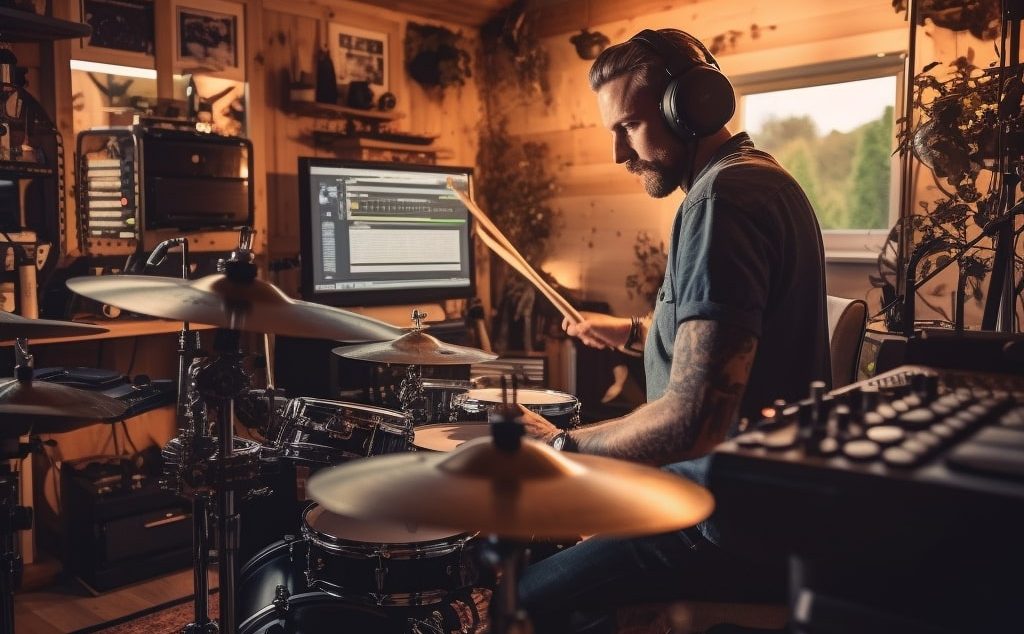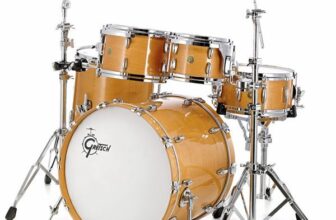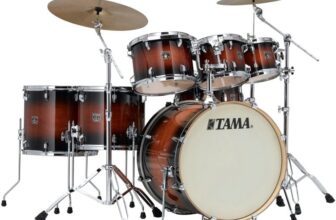In this article, I will teach you how to connect electronic drums to a computer.
There are two ways:
- Record as midi – more control; you don’t need an audio interface
- Record as audio – less control, you need an audio interface
So, if you plan to do drum covers, make sure you decide right away if you want to bother yourself with mixing drums and setting up everything or if you just want your electronic drum sound captured as it is.

How long does it take to connect?
For midi recording, it’s only one cable, but it will take around 30 minutes for the first setup. Every subsequent time, it will take less than 10 minutes.
For audio recording, two cables, but since there is no mapping and selecting different outputs and inputs, it takes less time, no more than 10 minutes as well.
What you need
Assuming you already have your electronic kit and a computer/laptop.
– For midi recording, you need only two things:
- A/B USB cable – used to connect your drum module to the computer
- DAW – used to record your electronic drums
It has USB A on one side and USB B on the other.
In case you want to connect an electronic drum to a laptop, you may need this kind of adapter.
This is a must if you use newer Apple models because they only have USB-C ports.
– For audio recording, you need three things:
- TS or TRS cable – used to connect the drum module to the audio interface
- A/B USB cable – used to connect an audio interface to the computer
- DAW – used to record sounds coming from your drum module
Assuming you are new to the world of recording and music production, I suggest a few straightforward DAWs like:
- Garage bend that comes pre-installed on Mac
- Audacity – available for Windows also, and it is free.
For the ones serious about recording drums, I suggest using:

Recording Electronic Drums as MIDI
The MIDI recording method allows for intricate sound manipulation. It is ideal for drummers who want to edit, add external sounds, or change existing ones after recording. It captures the performance as MIDI data, which can be easily adjusted for note pitch, duration, and intensity.
Connecting to a Computer:
Method #1
- Plug in the USB B side of the cable to a drum module in a place where it says USB COMPUTER (it can be written something different, but every electronic drum has only one USB port like this)
- Plug in the USB A side to your computer. For laptops that only have USB-C, use the adapter.
Method #2 is for modules that don’t have usb port, but you will need an audio interface and a midi cable.
- Connect the MIDI cable to the MIDI OUTPUT port of your drum module
- Connect the other end of your audio interface to MIDI input
- Connect your audio interface to a computer
You reverse this method and send sounds from your computer to a module.
Now, when everything is connected, it is time to download the driver software so your computer can recognize and communicate with your drum module.1
Here’s what to do:
- Go to the manufacturer’s website
- Search for the page where you can download the driver. Here’s what Roland’s page looks like.
- Find your device
- Download a suitable driver based on your operating system

Recording Electronic Drums as Audio
This approach is the more straightforward, so it’s NOT that I want to play around with my drum sounds, but I want to record drum covers even with my phone.
Yes, you can record electronic drums with your phone,
I will show you.
Connecting to a Computer:
Here are the steps:
- Connect the TS or TRS cable to your drum modules’ MAIN OUTPUT
- Connect the other end of cable to your audio interface
- Connect your audio interface to your computer
You will also need a driver for this approach:
Here’s what to do:
- Go to the site of your audio interface manufacturer (this time, you don’t need your electronic drum manufacturer driver). Here is what the Focusrite driver page looks like.
- Find your device
- Download the driver based on your operating system.
Connecting electronic drums to a phone
- Acquire an iRig2 or similar device designed for mobile connections.
- Connect the TS or TRS cable to your drum modules’ MAIN OUTPUT.
- Connect the other end of cable to your audio interface; in this case, iRig2
- Open your camera app and start recording to capture both audio and video.
If your mobile phone doesn’t have a 3.5 mm jack port, you can use an adapter like this one.
Recording electronic drums in a DAW
If you did everything right by now, you should have everything working correctly. Now it’s time to set everything up in DAW so you can start recording.
I will not go in-depth since I have an entire guide on how to record electronic drums.

Recording electronic drums as a MIDI
The sound comes from a drum plugin, and your electronic drum kit is used only for control, so make sure you have your drum plugin loaded.
Here is how to do it:
- Open Your DAW
- Create a New Project.
- Enable MIDI Devices: Go to your DAW’s Preferences or Settings and look for the MIDI or Audio MIDI Setup section. Make sure your electronic drum kit or MIDI interface is enabled as a MIDI input device.
- Create a MIDI Track
Set Up MIDI Mapping (If Necessary)
If the default mapping of your drum kit doesn’t match the software instrument’s mapping, you may need to adjust it. This means you need to select proper inputs and outputs.

Recording electronic drums as audio
With this method you’ll be able to capture your module sounds, unfortunately in a single channel. Which means, no control over each component.
Here are the steps:
- Open you DAW
- Set up audio preferences: Go to your DAW’s Preferences or Audio Settings. Set your audio interface as both the input and output device.
- Create an Audio Track: Add a new audio track to your project.
- Assign Inputs: In the channel settings for the new audio track, assign the appropriate input from your audio interface. If you’re recording in stereo, make sure to select a stereo input or two mono inputs (for Left and Right channels). For mono recording, just select the single input you’re using.
- Arm the Track: Enable the track for recording by arming it. This is usually done by clicking a “Record Arm” or “R” button on the track.
Common issues and how to solve them
1. Latency – Delay between hitting a drum pad and hearing the sound through headphones or speakers. Here is what to do:
- Open Your DAW: Launch the DAW you are using for recording or producing music.
- Access Audio Settings: Look for the Preferences or Settings menu. This is often found under options like “Edit,” “Settings,” “Preferences,” or a similar menu item. Within this menu, navigate to the “Audio” or “Audio Setup” section.
- Find Buffer Size Settings: Within the audio settings, look for an option labeled “Buffer Size,” “Buffer Length,” “Audio Buffer Size,” or something similar. This setting is usually adjustable with a slider, a dropdown menu, or input fields for numerical values.
- Adjust the Buffer Size: Lower the buffer size value. Smaller buffer sizes reduce latency but require more from your computer’s CPU. Start by reducing the buffer size incrementally (e.g., from 512 samples to 256 or 128 samples) and test the performance.
- Test for Performance: After adjusting, test your setup by playing or recording in your DAW. Listen for any audio glitches, pops, or dropouts. If you experience performance issues, increase the buffer size slightly until you find a balance between low latency and smooth audio playback.
2. Connection Issues – The computer or DAW does not recognize the electronic drum kit or audio interface.
- Solution: Check all physical connections and ensure cables are securely plugged in. Restart your computer and the connected devices. Verify that the latest drivers are installed for your audio interface or MIDI device. Sometimes, changing USB ports or using a powered USB hub can solve connection issues.
3. MIDI Mapping Problems – Drum hits trigger the wrong sounds or no sound at all.
- Solution: Check the MIDI mapping settings in your DAW or drum software/plugin. Adjust the mapping to match your drum kit’s MIDI output. Some DAWs and plugins allow you to manually map drum sounds by learning MIDI input from your kit.
4. No Sound – No sound comes from the DAW or speakers when playing the electronic drums.
- Solution: Ensure the track is armed for recording and monitor input is enabled. Check the volume levels on your drum module, audio interface, and DAW. Verify that the correct input/output channels are selected in both your DAW and on the audio interface. For MIDI, ensure the drum plugin or virtual instrument is loaded and correctly mapped.
5. The computer Won’t Recognize the Device. – The electronic drum kit or audio interface does not appear in the DAW or system settings.
- Solution: Ensure the device is powered on and correctly connected. Check for any necessary drivers or firmware updates on the manufacturer’s website. Try connecting the device to a different USB port, preferably directly to the computer rather than through a USB hub. Restarting your computer can also help recognize newly connected devices.

Frequently Asked Questions
Do I need an audio interface to connect my electronic drums to a computer?
Yes, if you want to record the sound of your drums as audio, an audio interface improves sound quality. However, to use the drums as a MIDI controller to play virtual instruments, you might only need a USB or MIDI cable if your drum kit supports a direct computer connection.
What cables do I need to connect electronic drums to a computer?
You need either a USB cable (if your drums support it) to connect directly for MIDI or two 1/4″ TRS cables (for stereo output) and an audio interface for audio recording. For MIDI without USB, a MIDI to USB cable or interface is needed.
How can I use my electronic drums as a controller for virtual instruments?
Connect your drums to your computer using a USB or MIDI cable, select your drum kit as a MIDI input device in your music software (DAW), and then you can play and control virtual drum kits or other instruments within the software with your electronic drum pads.
My name is Denis. I am a drummer, percussionist, music enthusiast, and blogger. Drums have been my passion for 15 years now. My idea is to write about the things I like and I am interested in. I want to share my drum passion with fellow musicians who walk, talk, and breathe drums.






